Let’s say you’re a first-time chicken owner, and you’re ready to tackle this backyard chicken gig.
You can’t resist the temptation at the feed store, so you find yourself driving home with a box of chirping, fuzzy yellow chicks in your lap. At $3-$4 per chick, that’s a small price to pay for beautiful, home-raised hens that will give you your own eggs for free, right?
Wrong.
Here’s the problem… There’s no such thing as a free lunch and no such thing as a free egg.
As many of you already know, those fluffy yellow chicks (aka the gateway drug to homesteading…) are actually one of the cheaper aspects of keeping chickens. Once you succumb to the magnetic draw of feed-store chicks, expect to keep opening your wallet for:
- A chicken coop/run (here’s my guide for chicken coops, by the way)
- Chicken Feed (if you want an organic or non-GMO feed, expect to pay the big bucks)
- Waterers/feeders
- Shavings/bedding
- Heat lamps (if you use them)
- Electricity for the coop
- And any other random chicken accessories that might strike your fancy.
Of all the items on the above list, the one we chicken-addicts talk about the most is the feed. Why? Because buying good chicken feed at the store is so expensive it’s almost physically painful.
For example, buying a good quality organic Non-GMO chicken feed like Scratch and Peck, you will be spending $40 for 25 lbs.
Ouch.
So, homemade chicken feed has to be cheaper, right?
Eh, maybe. But don’t count on it.
In fact, more often than not, by the time you hunt down all the (semi-strange) ingredients you need to build a good homemade chicken feed, it’ll actually cost you more… And if you want to keep your flock healthy and producing well, you must make sure you are feeding them with the proper balance of protein, energy, and nutrients.
Unfortunately, you can’t just toss them some corn and call it good…
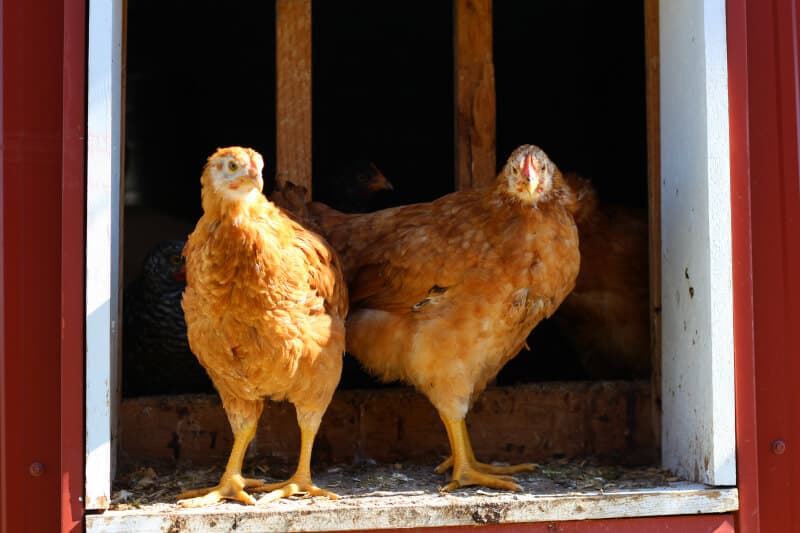
What a Balanced Chicken Feed Needs
Like with all living things proper nutrition provides chickens with the energy they need to develop. There are five main building blocks to a well-balanced chicken feed, including Carbs, Fats, Proteins, Minerals, and Vitamins.
Without getting too deep into the science of chicken feed, here is a rundown of each nutrient and why it is important.
Five Main Chicken Feed Nutrients
- Carbohydrates
Carbohydrates are the largest portion of a chicken’s diet. These are used as a quick source of energy and are used as a source of fuel. Some common carbohydrates that can be found in chicken feed include corn, barley, wheat, and millet. - Fats
Fats, also known as fatty acids produce more calories and help chickens absorb fat-soluble vitamins A, D, E, and K. The addition of fats to chicken feed can also help in cold climates during winter months. Saturated fats that can be added to a chicken’s diet include lard and tallow. - Proteins
Proteins are an important part of a chicken’s diet because it helps with the development of the chicken’s body (muscle, skin, feathers, etc.) Animal-based protein includes fish meal, meat, and bone meal. Plant-based proteins can include soybean meal, canola meal, and corn gluten meal. - Minerals
There are two classifications of minerals Microminerals and Macrominerals. Microminerals include things like copper, iodine, iron selenium, and zinc. Macrominerals include calcium, phosphorus, potassium, and sodium. Both types of minerals help with bone production, and muscle and nerve function.Grains tend to lack the necessary minerals needed for a healthy poultry diet, that is why supplements are available. For example, the recipe below contains Nutri-balancer or another great source for calcium is free-choice oyster shells. - Vitamins
Vitamins play an important role in chicken growth and reproduction. Some vitamins can be produced by the chickens, but others are supplied by natural food provided and supplements.
If you are interested in the full scientific explanation of the nutrients in chicken feed the following articles are very helpful.
Chicken Feed Nutrient Articles:
When you are buying or mixing your chicken feed it is important to remember that nutritional needs can vary depending on your chickens’ age and purpose. A chick will have different needs than a mature hen and a layer will have different nutritional needs than a broiler.
For a better look at what each age group and type of chicken will require take a look at the feeding chart provided by The University of Georgia Extension in this Article.
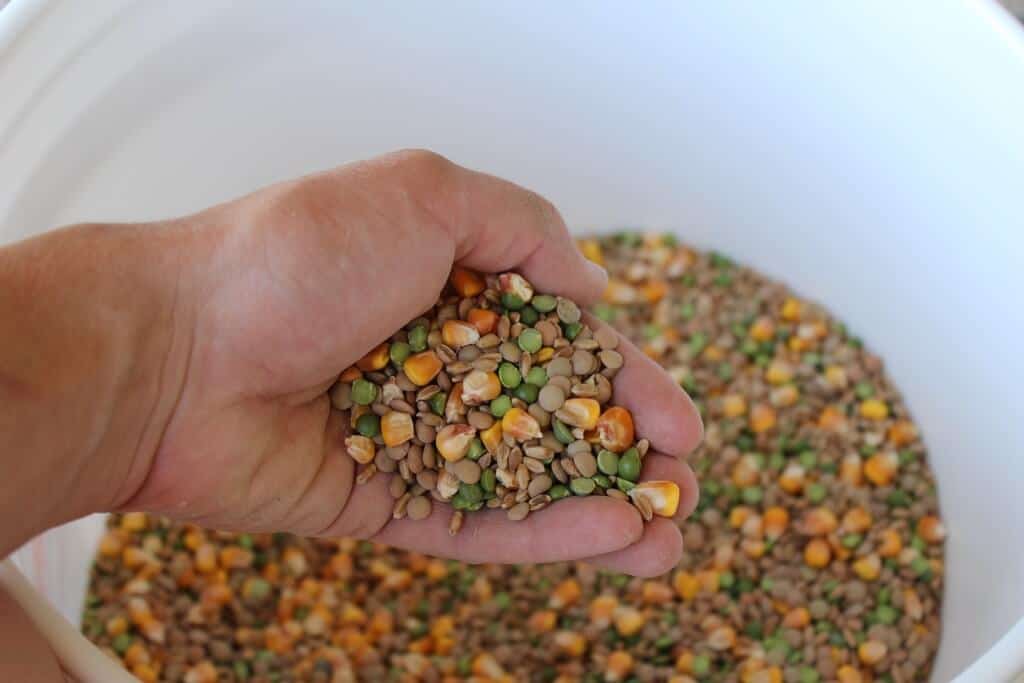
Mixing Homemade Chicken Feed
Before we jump into mixing homemade chicken feed, it is important for you to decide if it really is your best option. There are a few benefits of mixing your own chicken feed but it also has its challenges.
Benefits of Homemade Chicken Feed
- Ingredients are more flexible, you can adjust a recipe based on what ingredients are available to you.
- You are able to provide the most natural as possible diet.
- You will know what your flock is eating and will be able to control it
Challenges of Mixing Homemade Chicken Feed
- Ingredients can cost more.
- Your Ingredients may be hard to find based on where you are located.
- Mixing Feed can be a challenging time-consuming ordeal.
- If you have picky chickens, they may pick out certain whole gains and waste feed.
Homemade Chicken Feed Recipes
I’ve been ordering a custom-mixed feed from the local feed mill for 2 years now. (It’s the whole grain, non-GMO recipe you’ll find in Natural Homestead: 40 Recipes for Critters & Crops, in case you’re wondering)
Unfortunately, it’s not super easy to put together, and I could only find ONE mill in my area that would even attempt to help me with it.
So, when I saw that my favorite permaculture chicken guy, Justin Rhodes, had a favorite non-fussy homemade chicken feed formula he uses and loves, I was all over it.
I asked him if I could share it with you today, and he said YES. (Thanks Justin!)
(By the way—his YouTube channel is my #1 fav—you gotta check it out!)
A Few Important Notes About This Homemade Chicken Feed:
- As stated above, this is Justin Rhode’s recipe. I personally use a custom-mix that my local feed mill helps me to put together. The recipe for that mix is in my Natural Homestead book. However, it is a more complicated formula (with more difficult ingredients), so I wanted to share Justin’s simpler option.
- You do not have to grind the grains– just feed them whole.
- There are no lentils in the recipe. The photos in the post (with lentils in them) were shot a while ago, and I thought they’d be a good fit for this post. This particular recipe does not contain lentils.
- Since I have my feed mill custom-mix me a different recipe, I do not have price breakdowns for this particular recipe.
Simple Homemade Chicken Feed Recipe Formula
- 30% Corn
- 30% Wheat
- 20% Peas
- 10% Oats
- 10% Fish Meal
- 2% Poultry Nutri–Balancer
- Free Choice Kelp
- Free Choice Aragonite
Mix together and feed as you would any other chicken feed. Since you are using whole grains, your feed should not lose its nutritive content as quickly as more processed feeds.
About the Ingredients:
- If you want this to be organic/non-GMO, you’ll need to source organic/non-GMO corn, etc. That may or may not be possible in your area.
- If you want to purchase kelp in larger quantities, I often get the 50 lb bags of Thorvin Kelp from Azure Standard. I also feed kelp to my cows, goats, and horses.
- The Poultry Nutri-Balancer is a vitamin/mineral supplement designed to keep your flock in tip-top shape. Even if it’s slightly more complicated for you to source, I wouldn’t skip it. Here’s a dealer locater to see if you can find it in your local area.
- Aragonite is a source of calcium, which is vitally important, especially for layers. Another calcium option is crushed eggshells.
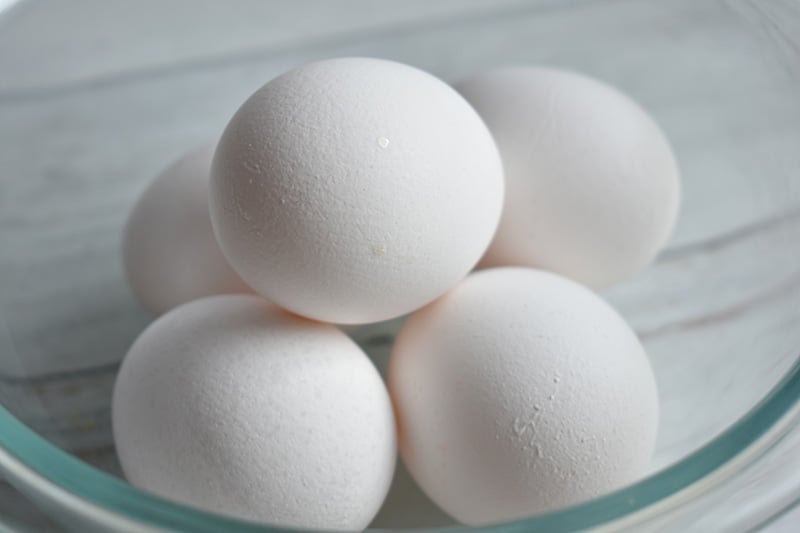
This homemade chicken feed recipe is great because it is a flexible chicken feed formula, you can make a small amount or a large amount.
Chicken Feed Note: No doubt, I will get some emails over this post. There are websites/books/etc that turn feeding chickens into rocket science. Admittedly, you DO need to be careful in how you are balancing rations.
However, I always go back to the fact that great-Grandma was keeping her flock productive long before there were shiny bags of “Chicken Chow” at the feed store. I do hesitate to overcomplicate the matter. Plus, when someone with WAY more chicken experience like Justin Rhodes has consistent success with a recipe like this, I trust that.
If you are looking to Cut Your Chicken Feed Costs Even More…
Not only did my friend Justin generously allow me to publish his feed recipe, but he also has some Chicken Tips Videos you can watch for FREE. Justin shares 20 of his best stunts for reducing chicken-feed costs!
Like I mentioned before, I always appreciate Justin’s information– it’s meaty, specific, and actionable. Without fail, he always shares tips I would have never thought of on my own!
Get Your FREE Chicken Tip Videos Here.
-> As I mentioned earlier raising chickens does not mean free eggs, but sometimes that means ALOT of eggs. You can cut costs by selling your extra eggs, this is something I like to call self-funding your homestead. Chicken and eggs are not the only ways to self-fund your homestead.
If you are interested in creating an income from things you are already doing on your homestead then The Self-Funded Homesteading Course is probably the right fit for you.
To learn more about my mission to help other freedom-seekers create a self-funded homesteading business, CLICK HERE. <-
Are You Ready to Try Homemade Chicken Feed?
Over the years, I have received emails from people in an absolute panic over what to feed their chickens. GMO/non-GMO, organic/non-organic, homemade/purchased—there is, indeed, a lot of options out there. But here’s the deal—we can’t control every aspect of our lives. Even if you (or your chickens) are eating the most perfect diet in existence, you/they will still likely be exposed to toxins in the air, soil, water, etc. This is just a side-effect of living on an imperfect planet.
We Can Only Do Our Best…
Do the best you can and even if you can’t find the perfect chicken feed ingredients. I know at the end of the day I have peace knowing I did the best I could and my chickens are still eating 100% better than industrially-farmed chickens. Maybe homemade chicken feed isn’t an option for you, there are still so many different ways to feed your chickens. Here is a list of 20 Ways to Save Money on Chicken Feed if you are not ready for a homemade feed.
Please don’t lose sleep over chicken feed.
Other Homestead Chicken Posts You’ll Like:
- Saving Time by Using Chickens on the Homestead
- Beginner’s Guide to Laying Hens
- Fly Control for the Chicken Coop
- 8 Ways to Use Chickens in the Garden
- Herbs for Nesting Boxes
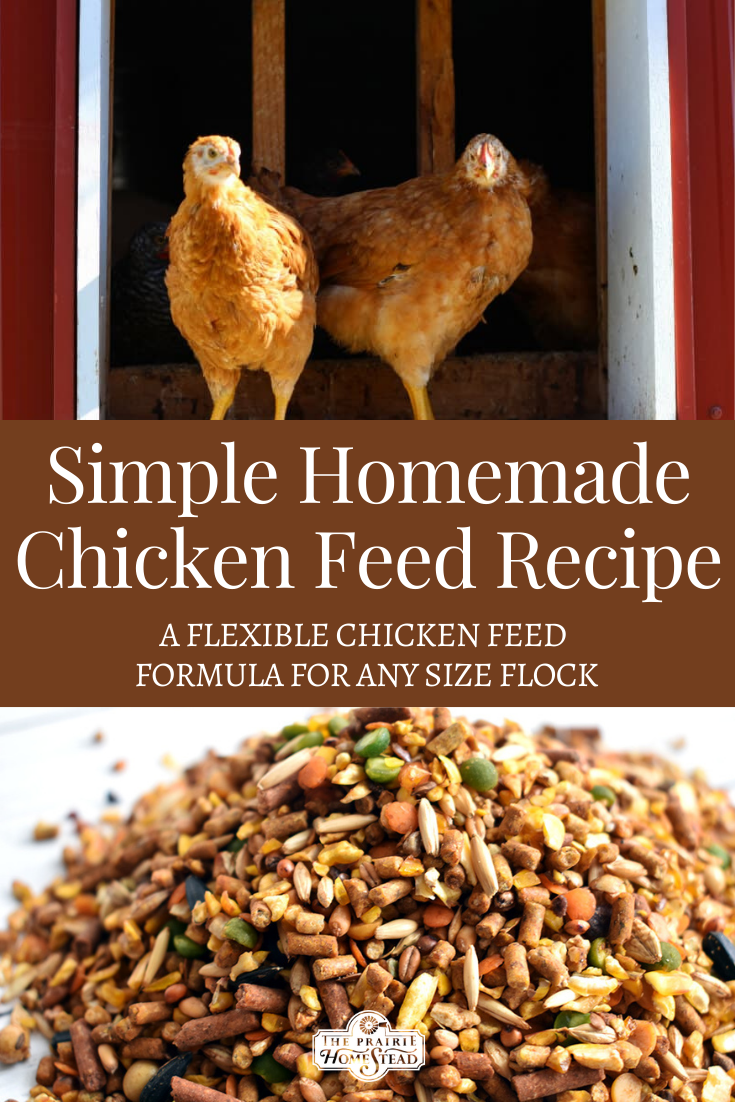
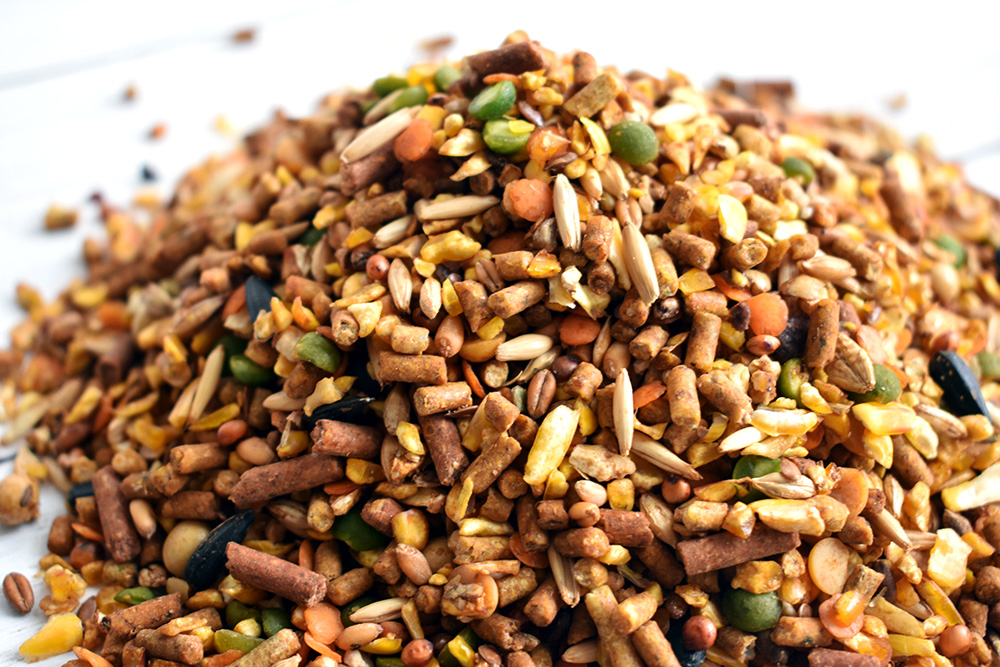

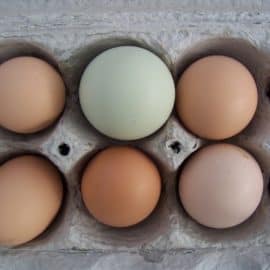
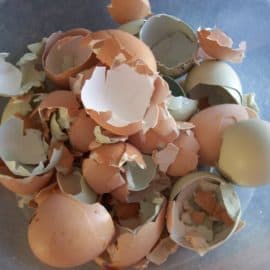
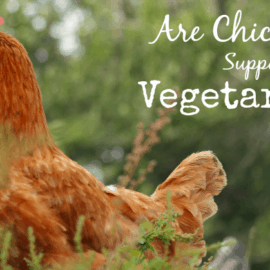
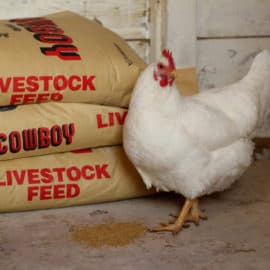
Hi Jill! Absolutely love your blog! I have gleaned so much information and inspiration from you.
I also live in Wyoming, north of you, around Torrington. I was wondering where you sourced your legumes, also the Nutri-Balancer?
Hey Colleen– you can get the Nutri-Balancer here: http://www.newcountryorganics.com/shop/animal-health/vita-stuff/poultry-nutri-balancer-10-lb-bag.html
And in the past, I’ve gotten my legumes from azure standard.com
I went to this page and went through all the hoops of entering addresses etc only to find they charged almost $18 to ship a $23 product. Do you have any other sources or substitutes? Thank you!
I live near Sheridan and there is an Azure Standard drop here. They sell the nutri-balancer. What I can’t seem to find is fishmeal..
Where is a good source of fish meal? I can’t find it on azure. Is there something I can sub?
A) You don’t have to feed chickens…pasture raised chickens receive no feed mix. I only feed my birds in the winter, the rest of the year they’re free ranging. I only pin them up at night.
B) Organic is non-gmo, so you don’t have to pay for both labels.
C) Tractor Supply has an organic feed in a 40# bag for $26, it’s by Nature’s Best.
That’s what I use. I ferment some of it (mash!) in which I add treats (meal worms, marigold petals, kale, whatever I have at the moment; sometimes scrambled eggs!
Please tell me all about fermenting the chicken feed. I am new to this and I’m very interested to learn.
this is a pelleted feed though, isn’t it? i like to ferment my chicken feed and you can’t ferment the pelleted feed.
Yes you can ferment pelleted feed.
Cassie Read your label on the Tractor Supply “organic” feed. You really have very little in that feed: Copied from their product description, “Organic Corn, Organic Soybean Meal, Organic Roasted Soybeans, Organic Wheat, Organic Alfalfa, …” Basically Soy isn’t a great ingredient as it first is a by product them using the meal, The corn is just fat and not a good diet add-in, and then Roasted Soybeans, so they cooked the crap out of some leftover soybeans and added those, also a by product, … Wheat is good, Alfalfa is good, But look what is missing. What chicken walks into the field and eats the left-over outside shell of something. Read your label and omit corn and soy, then the rest should read, ” WHOLE SEED …. ” like Wheat, Barley, Oats, Peas(Cracked or whole), etc. … I have done feed studies, and our birds lay for YEARS, steadily for 5 but as long as 8 or 9 years later they are laying some. … If you want to ferment whole seed you can and the production increases even higher. … Mainly don’t be fooled by a package or large company. Take a look at a brand called, “Scratch and Peck Feeds” label and then find something close to that near you.
Excuse my ignorance, but are lentils bad for my birds?
How do you keep them say from Hawks, or other predators when they are open ranged?
Organic means non-gmo but non-gmo does not mean organic. You will still get pesticides like glyphosate in your feed if it is non-gmo. Organic feed will only use pesticides that are certified for organic use. Not perfect but better than not organic.
I pasture my chickens on five acres. The Icelandics find what they need. Other breeds are not half as good at finding everything they need. They are not bred for it. I always check that crops are full in the evening. Supplement as needed.
How much space do you need per chicken when feeding free range only? If you have a couple dozen chickens, how much space would they need to have enough to keep healthy and lay eggs?
Jill, I know this is a few months old, but I am just now seeing it. (I go away for awhile sometimes, but I always come back to you. ?)
I agree SO MUCH about your comment that grandma wasn’t getting into the science of it! I sometimes get exhausted with people insisting that things have to be perfect for the chickens to do well. Chickens haven’t been around for thousands of years because of Tractor Supply.
Can you provide a link to the fish meal? Is it ok to buy fish meal that is designated for the garden or should it be a different one? Thank you!
Hum…good
Blessed be! I am in BC, Canada, and thrilled to find you! We are allowed to have chickens here but it is a bit too windy, so I may wait til we move. Thank you for ALL the information!
What are the exact ingredients you use, I’m getting more and more confused as I am reading your post. I feel when someone asks you an ingredient you give a round about answers. Can we just have your recipe you took a picture of and pinned on Pinterest please. We all would love to use it! Thank you
Nice article but just to comment–this isn’t really “homemade” feed in the true sense that you are growing these ingredients on your land and using them as feed. If you did this, you would find this to be a cheaper and natural alternative. This explains why the method you explained here isn’t a cheaper alternative. Most people need to change their mentality of what’s natural and start growing their own food for feed. Otherwise, you are just subject to manufacturer’s marketing and gimmicks selling you on being independent and organic. If you don’t have the space to grow your own crops, then you aren’t saving any money (nor having any independence) with growing your own chickens from big business.
Hiram
Hi Hiram,
Can you share which crops you grow for you chickens? Thanks
Following. I wish to go that way as well! To grow all the needs to feed chickens would be the only way to go, if you have the land
I to am from wyoming. I love your blog. It gives hopefully homesteaders like myself hope that it is possible with the crazy wind..sudden weather changes.. poor soil! :). I would also love info on where you get your chicken feed! Thanks for blogging!
Hello fellow Wyoming-ite! So glad you’ve been enjoying the blog. I get my other chicken feed recipe custom-mixed at the Z&W Feed Mill in Torrington, WY.
Is the mix ground up or left whole?
It’s left whole.
I called them yesterday and they don’t have any kind of peas. Is there a substitute you use?
I personally use a custom-mix that the mill helps me to put together. The recipe for that mix is in my Natural Homestead book. However, it is a more complicated formula (with more difficult ingredients), so I wanted to share Justin’s simpler option here. In the past, however, I’ve gotten peas from azure standard.com
Can they have field peas?? I have read that they shouldn’t….but I remember reading somewhere that either my goats or chickens could because I purchased them:{ I also purchased barley?!?!?! and I am making sure that they don’t have to be sprouted? So much great info filling my head haha..and very new to animals. Trying to get a healthy mix and then I forget who said what for which animal:}
I have seen chicken feed recipes calling for field peas. 🙂
You can purchase the peas from any grocery store. They are split peas.
If I wanted to purchase this in Torrington, what would I ask for? I was mixing my own but it’s so messy. I bought a mix in Fort Collins but it’s layermash and I’d like whole grain.
Thanks,
Renee Brooks
Cheyenne, Wyoming
( we met this summer at the meet up)
When you say in additional notes that you can add egg shells as the calcium, I was curious if you can also just use oyster shell instead?
Research oyster shells and see if that would be a good fit with the feed recipe and the nutritional needs of chickens. If you think it will be safe and good, give it a try and see how your chickens fare. Best of luck with your research!
I see lentils in the pictures but no other mention or ratio in the recipe? Thanks for clarifying!
Sorry about that– there are no lentils in the recipe– this was just a photo I had taken a while back and wanted to use it.
Can you give lentils to chickens though? I thought whole wheat wasn’t good too?
In the photos, it looks like you used red lentils instead of oats?
Sorry about that– there are no lentils in the recipe– this was just a photo I had taken a while back and wanted to use it.
I love this! My grandpa raised ducks and chickens for years and years without any commercially made prepackage stuff. 🙂 Would this work for ducks or do they need different food ingredients? I am new to raising ducks and would love to feed them something that is good for them! Thank you so much 🙂
We have ducks, and they eat the same things as the chickens. They only need extra niacin as ducklings, but other than that, they can eat chicken food.
Our ducks just eat the same stuff as our chickens. 🙂
I like to give my ducks a banana or two a week as an added snack
Hello I just started with 5 chickens
And I am having so much fun one thing they love are mealworms
Justin has a YouTube channel up right now and he has 2 ducks in with all of his chickens. He feeds them the same thing as the chickens. He soaks the grains overnight.
We LOVE Justin’s daily vlog! Watching their sweet family working together motivates us
To get out and do the same! Great post today – Tool box #76 is tops!
Thanks Kathy! And yes, Justin’s Vlogs are the best!
I am having a hard time sourcing the fish meal. Any tips on where to find this? I live in California so I don’t think it should be this hard but I’ve actually been looking for a couple weeks already as we watch Justin’s vlog so I already had the recipe, but have had no luck finding it. I can get nutri balancer from azure standard (for a pretty penny…$97!!!) but can’t find the fish meal anywhere. I don’t feel like this can be skipped as its a vital protein source.
I’m in northern Canada where everything is hard to source so much buying online. I get fish meal (and kelp meal) from Amazon – free shipping. 🙂
This is part of the reason DIY chicken feed can be so complicated, unfortunately. I get fish meal through my local feed mill (I actually use a more complicated recipe that they custom-mix for me. Justin was just kind enough to let me include his formula here for folks who don’t want to make my more complicated version).
I get fish meal out of our lake. Go fishing, keep everything you catch and run it through the chum grinder. Feed it to the chickens about once a month. If chickens can eat bugs, they can eat fish too.
I was wondering about that. We have a lake on our property and I was hoping we could just use the fish scraps after they have been filleted. What is a chum grinder?
You can buy mealworms they love them and a healthy snack you can look into raising your own mealworms as well
baby chick starter and grower for broilers!! good basic recipes ??? I have ground grains before, for chick starter, balancing act gets very interesting, any suggestions???
Unfortunately for starter/grower, I always just use commercial feed. Anytime I’ve looked into it, it’s gotten too complicated trying to balance out the required ingredients.
Thank you Jill for this post. I have been following you and Justun Rhodes for a bit now. I got my first pullets a few weeks ago. They are about 5-6 weeks old now. I have been feeding the commercial starter/grower crumble and they are doing great. I what age would it be best to switch them over to the feed recommended by you and Justin? Do they need to be transitioned to the change in feed or can they go from the starter to home made feed without issue? Thank you. I look forward to your reply.
Hi Jill!
You now I am a lover of all your stuff…blog, facebook, I get excited about e-mail….I have a question..you mention the feed is $38 for 25 pounds…..I’m wondering how much a chicken eats in a day…..or how long does that 25 pound bag last for how many chickens?
Hi Nancy, Unfortunately, I don’t think there’s an easy answer for that. It depends on their age, what else is in their diet, if they are free-ranging, the time of year, etc.
dried soybeans good for chickens?
No! Don’t feed chickens soy! It transfers to the eggs and to the people that way them. And many people can’t have soy!
what if I’m the only one eating the eggs and I can have soy is it ok then?
Thanks for the great info!
We are new to chickens and so far have only fed them regular store bought feed because I just couldn’t figure out any other option in my area.
Thanks to you, I can now work on this combo and see if I can make it work – Thanks again!
~Karina
Hope it works great for you Karina!
Thanks for this post! I’ve been wanting to start making our own chicken feed and didn’t know where to begin. I will definitely be mixing up a batch for our hens very soon!
Hope it’s a big success for you Debbie!
Loved this today! Can you share the link for Amazon, my searches keep giving me garden fertilizers instead of fish meal and kelp meal. Thanks so much for your blog!
Thank you for posting this. We are trying to come up with a more economical way to feed our chickens. What would you reccomend for meat birds? We are a small 1/8 acre farm that is looking to be more self sustainable. Feel free to check us out! mysocalledfarm.com
Since we just had our first batch of meat birds this year, I gave in and just bought meat bird feed this year. But hopefully I’ll have a DIY recipe in the future!
Very useful information to me. I live in Portharcourt and I am yet to know where I would buy the green peas and oat. I already bought the corn and wheat
Thank you for this! I also am having a hard time finding fish meal…I tried doing a bit of research to find the purpose of it in chicken feed, and if there’s a substitute. It seems it serves as a protein, and either that or milled soybeans. I’m not sure if you have any knowledge about this, but I’m wondering if black sunflower seeds can be used in place of it? I know it’s Justin’s recipe, but just seeking any advice from experienced chicken peeps! 🙂
Soybeans are not healthy for chickens or us at all. Black sunflower seeds and oats serve as a protein to. My 20 or more chickens are free range and I make a mix of 50 lb bags of corn, oats, rye, barley, and wheat that I get from our local feed store for $7.00 – $12.00 per bag. I add 25 -50 lbs. of black sunflower seeds to my mix. I give them 12-16 oz of my mix a day. My mix supplies me for 10 to 12 months. I also give them what ever I have left over from our meals. You can also give them peas or any other vegetables and fruit you want. I give them pumpkins in the fall which supply them with a lot of vitamins for their health during the winter. Hope this can help you.
I live in South Carolina and new to this! My chickens will not touch pumpkin. Hummmm
I live in Oklahoma and my hens won’t touch pumpkin either. Even tried baking them to soften but they still won’t eat it. I thought maybe because they were pen raised on only bagged feed before I got them. But they like zucchini and other veggies from the garden,so I don’t understand it. Sure wish they would since after Halloween so many are available
I’m in CA and my chickens love all things winter squash!!
This is great info. Thanks!
Carissa, how many chickens were you feeding have at the time you posted this?
I use an even mix of organic oats, rye, wheat, barley, and BOSS which is fermented year round. The dinos also are on a rotational pasture system and get various food scraps along with farmed live mealworms. It costs me roughly $20/ month to feed them.
I have been using fish meal for my chickens but I’ve been advised that it’s not good for your chickens. Because of high Mercury count is this true, can someone help me on this?
Yes, fish products can contain mercury. It does depend on the fish meal, though. Most recipes only include it in small portions. Unfortunately, it’s hard (read: impossible) to find an absolutely “perfect” protein source, so sometimes you just do the best you can.
I’m excited to try the chicken feed recipe! Even if it works out to be the same cost as commercial feed, it won’t have that ‘commercial feed’ smell to it! The birds already get roadkill deer when we can find it (and are driving a vehicle conducive to transport… and it’s still there on the way home ;). We’re blessed to have ample garden space, so excess will be planted for birds next year.
I have a question about the recipe, though. Are the proportions by weight or by volume??
Awesome!
and it can be either weight or volume.
Wowzers! $38??? We pay $13 for a 25 lb bag on non-GMO, antibiotic free formulated at our loan mill. I also give them fruits and veggies from the garden and sunflower seeds as added bonuses. I also toss those things with Oregano for the natural antibiotic properties. I’m fairly new to chickens, but I’ve found that a lot of research before hand and talking to those I know who love and raise chickens for the best advice. I haven’t paid anything for my babies themselves either. A friend of mine who raises them gave us one and fertilized eggs. We borrowed another friend’s incubator to hatch them. There is always a way. We also managed to get our paws on a lot of used wood and have paid very little for our coup. Thankfully, we live on 3 acres so we are able to free range.
Hi Jill , I’ve read that you shouldn’t give chicken dried beans. Is it safe to add dried lentils and peas to the mix or could it hard them?
I’ve never had issues with feeding my flock dried lentils or peas. 🙂
Hey Jill, for your readers that don’t mind using regular feed I buy layer crumbles for $12 a hundred weight.
Where do you buy at $12 per hundred wt?
I’d love to communicate with you about my little girl chicken, her name is Linda. I have a concern but almost never on pintrist. Is it possible to communicate with you by phone or email?
Did I miss the link for this Justin person’s YouTube videos? Scanning over again…
Here you go: https://www.youtube.com/channel/UCOSGEokQQcdAVFuL_Aq8dlg
It is important to have an analysis of the eggs to have the right balance of omega 3 & 6 the Hens might need more proteins. If there’s no right balance in the eggs this could cause some free-radicals /oxidation and can be dangerously for your health. It’s always good to get a commercial feed. I didn’t see any flax seed in the feed ?
I must confess to being very confused about why it’s so complicated to balance a chicken feed. What were people feeding chickens before commercial feeds? I wasn’t under the impression they went to a lot of trouble about it.
I agree, Rachel. And that’s a topic I’ve spent a lot of time thinking about. People have fed chickens for a long time before Purina came around… And the chickens survived and probably even thrived.
Why does the recipe add up to 102%?
Hi Jill,
I loved this blog post and all the posts I read of yours. I was looking at the the ingredients for the feed and was wondering what kind of oats are used. There are so many different kinds. When I was looking on Azure, they have feed grade corn and such. I would appreciate your help in this matter.
Where is the recipe? I can’t see it.
Could you send me please?
I agree with some of your readers. What did people do years ago before store bought feed. I’m sure the pioneers didn’t worry about the ratio of this to that. Also where (if they did) would they get it? Chickens have survived and produced for many years……before all this.
I just wanted to chime in super late. First off, this has been a very helpful post. Thank you!
Second, I wanted to throw an idea in the hat. There is a HUGE difference in the birds you buy today from the feed store and what granny kept “back in the day.” In other words, your Rhode Island Red is a very different bird than her Rhode island was. Research true standard bred chickens vs what the hatcheries put out, if u don’t believe me.
The birds you buy today have been getting commercial corn/soy based feed since probably soon after WW2. And guess whoes genes begin to dominate the breed/offspring. . . The birds who do the best on that feed, producing the most eggs on that food, and living without contracting diseases on that feed.
I 100% beelieve that these commercial feed developed birds CAN do well on pasture, veggie scraps, whole grains and some supplements. But we need to do our research and either buy standard bred poutry from breeders shooting for a bird who will do well on the type of feed we wanna give them. OR we do need to take the time to understand what these ladies need and try to provide it. . . without getting so worked up that we lose sleep over it. ?
In reply to these comments, I think they were assuming that most of the chickens who are receiving the feed, are cooped up and little pens, limiting the ability to get natural resources, such as grass flowers, insects pebbles, and lake free range chickens have much more access to these resources, and therefore probably don’t need as balance to feed, but if your chickens are cooped up, and they don’t have access to this, then a more balanced feed would be much more important to them I also feel that one of the things that seems to be missed here is if you’re willing to do a black soldier larvae feeder then your chickens can get a lot of protein from maggots sounds gross, but these feeders can be made easily for under $10 and are quite useful in bolstering chickens, diets who live in closed coops and runs
I’ve read many time never to feed dry beans or peas to your chickens yet your showing it here….. ???? Just wondering why I read no no no but you say yes
Fermenting or sprouting is the key to helping your chickens enjoy these nutrients.:) These methods, along with all the prior ingredients lsited and more, make it possible for them to obtain and process MANY more nutrients than they othere is would…and it helps with their digestive systems 🙂
Hello!
Thank you for all the information you share. Could you please tell me if you use the pellet style kelp? And when you free feed that how do you typically offer it?
Thank you for your help!!
Hi I was wondering what I could substitute for wheat? I have a friend with anaphylactic allergy to wheat.
You lost me when you said corn. Corn should never make up 30% of ANYTHING for a chicken. It’s like feeding a person 30% of their diet in sugar or candy. We only give it in the winter for them to add extra fat to their bodies. If chickens get too fat they don’t lay eggs! I’m calling this. They’d do better eating “crap food” from the local store than that mix. Anyone who knows chickens should know this already. Please people don’t take her word for it!!!
AGREE! Here in N. California we had Temps over 100° most of July. We have to stop ALL corn or they will overheat. Corn is a treat, not a staple.
Absolutely…. totally agree ‘re the corn.
Yes, the volume of corn in the recipe also concerned me!
A lot more than any other site and used mostly to keep birds warm in the winter…
There’s too much corn fear. Corn is an excellent energy source that supplies vitamin A—the only common grain to do so—as well as Lysine. And chickens like it a lot. Their eating corn is not really analogous to our eating it. Historically poultry folk have fed half or more corn. 30% is a great amount. Ditto for wheat, which can cause digestive problems if above 30%.
Justin’s mix is very well thought out. And all the pea hysteria. There is a LOT of bad info on the web, but this post is great.
Hi there! Do you ?now if they make any plugins to help with SEO?
I’m trying to get my ?log to rank for some targeted keywords but I’m
not seeing very ?ood success. If you know of any please share.
Thanks!
Folks thank you for all of the information, as I have read thru all of it. I can’t help but chuckle at listening to the prices of the ingredients and wonder “how is this saving any money”? Our local feed co-op sells an Organic Laying Mix for $8.50 for a 50 pound bag. Hard to beat!! Then you would have a bit of money in your pocket for fancy coops and treats. ?
Hey Jill I was just wondering if those ratios are by weight or volume? Thanks and have a great day!
Thanks too my father who told me regarding this web site, this webpage is truly awesome.
Thank you for the simple recipe! I’ve been hunting around and found several more complicated mixes, but I think this will be a good place for me to start.
I want the recipe not comments…where is it
We keep a dozen or so chicks for eggs, we’re vegetarians. We feed an organic feed for the girls. The fact is, in the old tyme days of gramma’s hens, they free ranged. Many were predated, many were eaten by gramma’s family. Very few lived past one or two years. Thay weren’t exposed to the toxic world we live in today. Most food was “organic” – LOL. It didn’t really matter what you fed them beyong corn or wheat.
What is the protein % for this recipe? I’m wondering if I can feed it to both my broilers and my egg layers?
Your blog is so helpful. We are building an extension to coop for feed as I want to mix my own and have started sprouting grains and fermenting. Loving having the chickens even though at sunset training them into coop is taking some time.
Do you have to cook or soak anything in this recipe?
Hello,
Just wanted to let you know that there is an error in your link to 2% Poultry Nutri–Balancer (where to buy)
the correct link is below
https://www.fertrell.com/poultry-nutribalancer
Thanks for the information
Thanks! We are uncharacteristically snowed in here in Eugene, OR. There is a natural food store within walking distance that I can get bulk items at. Since this feed is expected to be quite short term, I am going to do some adjustments. Due to necessity, I am going to replace the vitamins with some marketed for people: multivitamin replacing the 2% vitamins and the Argonite being replaced with ground calcium carbonate vitamin). Additionally I will feed them some cheese and yogurt. If I cannot find bone meal, I have some beef collagen, mg++ and phosphorus to add to the food. Thank you for the recipe. Our little close to the coast, close to sea level valley town really shuts down when we get significant snow & this has been record breaking!
so…what if you can’t use corn…what are your suggestions? See, I am very sensitive to corn…so the chicken can’t eat corn if I want to eat their eggs. Now I can eat the meat if they eat corn….Fun Fun.
I do play on using mill worms…but want more for them..
Hey I love the blog! I’m from Long Island, New York and I will be raising meat chickens this year. Does this recipe work for meat chickens as well?
In general, it should be fine. But I would look into it a bit more, as meat chickens need to be bulked up, while layers need to simply eat all the nutrients they need to produce and stay healthy.
I would like to try making poultry feed but have a question about your recipe. You list ingredients as a percentage of the total. Are you measuring by volume or by weight?
Which is easier to raise, chickens or ducks? Are ducks healthier, less vet visits and health problems then chickens? Can I use duck poo in my organic garden, like I would with chicken poo?
I don’t have any ducks or chickens yet, but plan on getting a few next year.
Could you tell me what kind of peas this recipe calls for? Are they called field peas?
It would greatly help if someone would clarify whether there is a risk giving lentils to chickens with scientific evidence. Clearly, there is divided opinion about this question.
Hi Jill. Thanks for all the good info. I keep running across Justin Rhodes recipe but I just have one concern. Do you ever have issues with weight gain considering the high content of corn? And if I fermented this would the corn ferment well? I live in AK so this would be great for winter, just not sure about summer. Thanks!
I would like your evaluation of the feed I have been using. My 28 Jersey Giant chickens are 4 and a half months old, and just started laying. Their feathers are glossy and the weigh between 3 and 4.5 lbs. I feed my chickens 1 scoop each of cleaned oats, black oilseed sunflower seeds, and cracked corn; and a half scoop of alfalfa pellets and whole corn. This mixture gets soaked with water for at least an hour. I also free feed (transitioning from starter to layer crumbles), grit and calcium. Apples are cheap in Virginia, and I can buy 10 for $3.50. I like to sit with them, cut an apple in halves, and hand feed them as a apples as a treat.
Your recipe provides aprox. 14.3% protein per pound of feed. Depending on the age shouldn’t the percentage of protein in the feed be between 16% – 20% per pound of feed? Can I suggest using Pigeon Peas which contain 22% protein and is easy to grow and can be harvested up to twice a year in the south.
Your link for where to buy nutri-balancer no longer works. Do you have an update for what you suggest?
Any comments on the fish meal giving the eggs a “fishy” taste?
Could I use meal worms instead of fish meal?
Meal worms and fish meal are not the same thing so switching one out for the other will change the nutrition statistics for the feed recipe. You might want to search for a safe chicken feed recipe that includes meal worms or reach out to your local extension office for some advice. Otherwise, you can simply give meal worms as an occasional treat in addition to this chicken feed.
I’ve been raising chickens for years and I have fed a little bit of everything. For the last few years I’ve been feeding livestock sweet feed. I start most chick’s on baby chick feed. The person that’s getting there hens to lay for eight years or more. I’d love to know how you do that. My Mother used to order 500 baby chick’s every spring. I enjoy reading your blog.
Hi, Do you suggest fermenting this recipe? If so, how?
Jill has not done much with fermenting chicken feed so we do not have any advice on this topic for you at this time. You can probably learn more about that through a google search. After you learn about how to ferment chicken feed, you hopefully can figure out if you can ferment this particular recipe or not. Feel free to come back and let us know if this recipe can be fermented safely! That would be great info to learn. 🙂
Wow, you really keep up on this blog. The range of dates in this comment section is phenomenal. Thank you for this recipe. I think it seems like a well-balanced recipe. I agree that corn is necessary for vitamin an and lysine so people should relax on that just a little bit. IT was curious what the protein content of this recipe was so that I can change it a bit for my meat birds since I raised my own meat birds. Since the rag night is just for calcium and I can get oyster shell cheaper I think I will continue to use that I found with your shell works quite well for my birds and I do also feed them back baked egg shells that I’ve crushed. I can’t wait to try this recipe. I think it seems very well balanced hi to worry a little bit about fish meal as if the grade isn’t good quality the bones in the fish meal can adversely affect the crops of the chickens but I think if a high enough grade is purchased, it should not be a problem. Also for people who are storing these ingredients. Be careful how you store a fish meal it can actually be volatile.
I love this homemade chicken feed recipe! It’s so easy to make and my chickens seem to enjoy it a lot. I like how you explained the benefits of each ingredient and how to adjust the proportions depending on the season. Thank you for sharing this useful information!